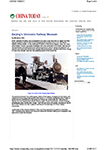Beijing’s Unknown Railway Museum |
 |
<<Click to see original |
Many residents of Beijing might be surprised if you were to tell them that the capital has three railway museums. Most know of the Zhengyangmen Exhibition Hall, in the old Peking Mukden Railway Station, on the south-eastern corner of Tiananmen Square; many, too, know of the Eastern Suburb Locomotive Exhibition Hall to the north-east of 798 District, that has over 100 locomotives and rolling stock from different periods in China’s railway development. Yet very few have even heard of the Zhan Tianyou Memorial Museum, let alone been there, though it is just a few minutes’ walk from the Badaling section of the Great Wall.
The memorial museum (中国铁道博物馆 – 詹天佑纪念馆) has a floor space of 9,600 square metres, arranged over two floors, and outside in the front is a large-scale granite relief, some 41 x 5 metres, highlighting Zhan Tianyou's portrait and his contributions to Chinese rail history. Inside there are 1,000 items on display such as mapping instruments, drawing paper, books, manuscripts, medals, insignias, and proposal plans, among other things. There are also some 600 photos, showing not just the life of Zhan Tianyou, but the general situation of China’s railway construction in the early days.
Construction of the museum started in 1984, and it was opened to the public in November 1987. It stands at the highest point along the rail line between Beijing and Zhangjiakou, close to the Great Wall museum.
Zhan Tianyou (詹天佑), or Jeme Tien-Yow as he called himself in English, is celebrated as the "Father of China's Railroads". His memorial museum stands near the highest point along the rail line between Beijing and Zhangjiakou, close to the Great Wall museum, and is arranged over two floors. Outside is a large granite relief, showing Zhan Tianyou's portrait and his contributions to Chinese rail history.
Zhan Tianyou was born in 1861 in what is now Guangzhou. In 1872, when he was 12 years old, he was chosen – together with 30 boys of the same age – by Qing imperial officials to be sent to the United States as part of the Chinese Educational Mission. In 1878, he entered the Sheffield Scientific School of Yale University, where he majored in Civil Engineering, with an emphasis on railroad construction.
However, the Qing government officials considered the behaviour of the foreign-educated students to be "un-Chinese", believing them to have become too westernised; and instead of utilizing their education to the fullest, they were detailed to work as translators or as officers in the newly formed Imperial Navy. Zhan was sent to the Fuchow Arsenal; but a few years later, in 1884, it was destroyed during the Sino-French War.
In 1888, he became an intern engineer, joining Claude W. Kinder, a British engineer, who had been hired to construct a railway that would link Tientsin with the coal mines in Tangshan. He was soon promoted to engineer, and later to district engineer. The railway that he worked on was later extended to become the Peking Mukden Line.
In 1902, Empress Dowager Cixi wanted a special 37 kilometres stub line built so she could visit the tombs of her royal ancestors; and eventually, Zhan got the position of chief engineer. He managed to complete the project within budget and to a very tight schedule; and it is said that the Empress was so pleased that permission was given to construct more railways in the country.
Following that success, the Imperial Qing government decided to build a railway that would link the capital of Peking to the important trading city of Kalgan to the north. Because of its strategic importance it was stipulated that no foreign engineers were to be hired. Capital would come from the government, and Zhan Tianyou was once again appointed as chief engineer. He managed to complete the work two years ahead of schedule and came in under budget. It was the first trunk railway designed and built by China and ran through Juyongguan Pass, Badaling, Shacheng and Xuanhua, over a length of 201 km.
Zhan included a zig zag section near Qinglongqiao railway station to overcome the steep gradient; and when excavating the Badaling railway tunnel, he accelerated construction by drilling a vertical shaft into the path of the tunnel, thus doubling the number of digging teams that could be employed. Its construction began in September 1905 and ended in October 1909, when it was finally opened to traffic.
In 1906 Zhan was also a technical advisor for the construction of the Lo Wu Bridge, which was built as part of the Kowloon-Canton Railway.
In 1909, Zhan was elected to become a member of the North British Academy of Arts and also to the American Society of Civil Engineers. He was also a founding member of the Chinese Institute of Engineers, and was awarded an honorary doctorate by the University of Hong Kong in 1916.
He worked on many other railways in his time; but in 1919, Zhan Tianyou died in Hankou, Hubei, at the age of 57. His final resting place was at Qinglongqiao Railway Station, where the Peking-Kalgan railway crossed the Great Wall.
